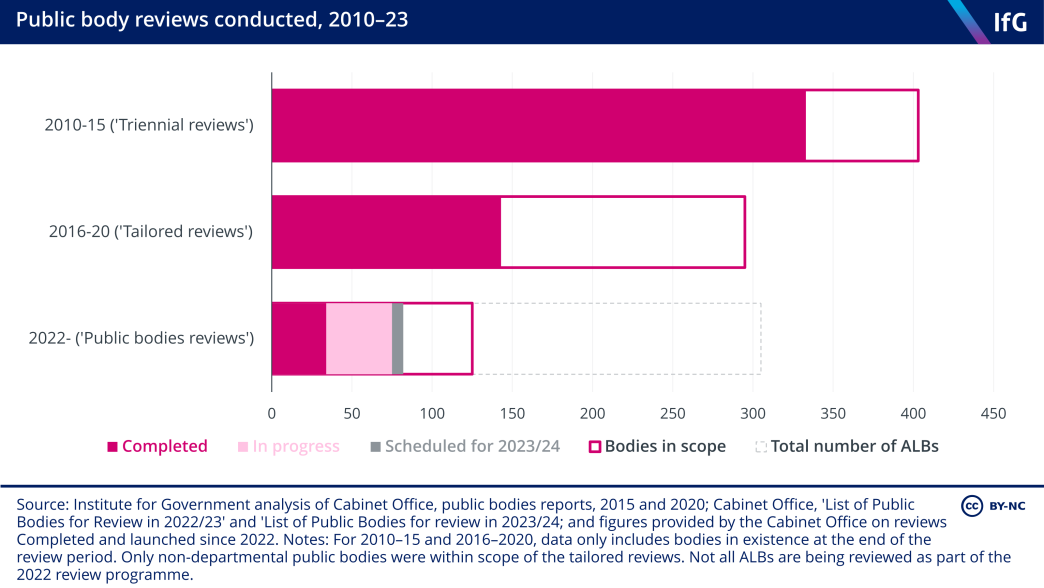
What is a public body review?
The Cabinet Office launched a new public bodies review programme in April 2022 to evaluate the governance, accountability, efficacy and efficiency of existing arm’s-length bodies (ALBs). 52 Cabinet Office, Guidance on the undertaking of Reviews of Public Bodies, Gov.uk, last updated 25 September 2023, retrieved 18 October 2023, www.gov.uk/government/publications/public-bodies-review-programme/guidance-on-the-undertaking-of-reviews-of-public-bodies, paragraph 80. A key role of reviews is assessing whether the function a body performs “remains useful and necessary” using the government’s ‘three tests’ and, if so, whether there are better alternatives to deliver the government’s objectives. This may involve merging the body with another government organisation or closing the body and bringing its functions back into a central government department. 53 Ibid, paragraph 16.
Once a review has established that an ALB remains the appropriate delivery model, the review considers whether the body has suitable control and governance arrangements in place, whether its relationship with its sponsoring department works well, and where cost savings could be achieved. Reviews are intended to be “constructive and challenging”, identifying areas in need of improvement and providing tangible recommendations for addressing them. 54 Ibid, paragraph 77.
Reviews usually involve a combination of both internal self-assessment and external research, as well as inspections and interviews with the leadership and staff of the body, and with key stakeholders.
Who conducts reviews?
Departments are responsible for selecting which of their sponsored bodies to review. They are encouraged to consider a range of factors including the size and strategic importance of the body, the length of time since it was last reviewed, and any significant changes the body might have experienced since. 55 Ibid, paragraph 123. The review process starts with the body under review completing a self-assessment. The department sponsoring the body uses this to determine whether it should be prioritised for a full-scale review. 56 Ibid, paragraphs 133-34. If a full-scale review is deemed unnecessary, the self-assessment is submitted to the relevant minister, sometimes accompanied by minor recommendations from the department. Ministers decide whether to implement the self-assessment’s recommendations or not, and may also request a full-scale review even if the self-assessment does not recommend one. 57 Ibid, paragraph 120.
If a full-scale review is requested, the minister appoints a lead reviewer, who must be independent of both the body under review and its sponsoring department. Ministers are encouraged to select from a pool of candidates compiled by the Cabinet Office, primarily made up of senior civil servants and non-executive directors or chairs of public bodies. 58 Cabinet Office, Lead Reviewer Role Specification, Gov.uk, last updated 25 September 2023, retrieved 18 October 2023, www.gov.uk/government/publications/public-bodies-review-programme/template-1-lead-reviewer-role-specification Alternatively, ministers may appoint other external reviewers with skills or experience relevant to the body under review. Judgement of the independence of the lead reviewer is at the discretion of the appointing minister. 59 Cabinet Office, Guidance on the undertaking of Reviews of Public Bodies, gov.uk, last updated 25 September 2023, retrieved 18 October 2023, www.gov.uk/government/publications/public-bodies-review-programme/guidance-on-the-undertaking-of-reviews-of-public-bodies, paragraph 98. A review team is also established to support the lead reviewer, usually made up of civil servants from within the sponsoring department. ALBs themselves should also provide input throughout the review process.
What happens once the review is finished?
When a full-scale review is complete, lead reviewers submit their findings and recommendations to the sponsoring department. Ministers have the final say on whether to accept or reject recommendations. The recommendations of the review and the responses of the department to them, including any justification for any rejection of recommendations, are then published. Departments are also expected to provide the Cabinet Office with subsequent updates on the implementation of any recommendations accepted. 60 Ibid, paragraphs 168-72.
How does the current review programme differ from previous iterations?
Government has a long history of public bodies reform. The current review programme follows a comparable process to the ‘triennial reviews’ of non-departmental public bodies which took place between 2010-15 and the ‘tailored reviews’ of ALBs which took place between 2016-20. This may reflect an attempt to replicate the perceived success of the triennial review programme, which achieved savings of close to £800m per annum in administrative spending. 61 Comptroller and Auditor General, Progress on public bodies reform, National Audit Office, Session 2013–2014, HC 1048, February 2014, www.nao.org.uk/wp-content/uploads/2014/02/Progress-on-public-bodies-reform.pdf, p. 21; Cabinet Office, Public Bodies 2015, last updated 20 April 2016, retrieved 19 October 2023, www.gov.uk/government/publications/public-bodies-2015, p. 8.
The current programme differs from its predecessors in four key ways:
- The government recognised the National Audit Office’s criticism that previous review programmes had not been sufficiently proportionate and had not met their ambition to review every ALB within a single Parliament. 62 Comptroller and Auditor General, Central oversight of arm’s-length bodies, HC 297, National Audit Office, June 2021, www.nao.org.uk/wp-content/uploads/2021/06/Central-oversight-of-Arms-length-bodies.pdf, p. 45. The current programme does not aim to review all ALBs: they are initially prioritised for review by their department, and further prioritised for a full-scale review following a self-assessment process.
- The Cabinet Office has set a specific target for potential financial savings that should be identified through each review. Lead reviewers are required to set out how savings of more than 5% of the body’s day-to-day spending could be made. 63 Cabinet Office, Guidance on the undertaking of Reviews of Public Bodies, gov.uk, last updated 25 September 2023, retrieved 18 October 2023, www.gov.uk/government/publications/public-bodies-review-programme/guidance-on-the-undertaking-of-reviews-of-public-bodies, paragraph 20.
- Tailored reviews were occasionally led by officials from the department sponsoring the body, with suggestions from some bodies that the lack of an external perspective undermined the objectivity of the process. 64 Comptroller and Auditor General, Central oversight of arm’s-length bodies, HC 297, National Audit Office, June 2021, www.nao.org.uk/wp-content/uploads/2021/06/Central-oversight-of-Arms-length-bodies.pdf, p. 36. Under the current programme, lead reviewers must be independent of both the ALB under review and its sponsoring department.
- For the first time, review teams are required to examine the wider “delivery system” within which ALBs operate, not just the body in isolation. 65 Cabinet Office, Guidance on the undertaking of Reviews of Public Bodies, gov.uk, last updated 25 September 2023, retrieved 18 October 2023, www.gov.uk/government/publications/public-bodies-review-programme/guidance-on-the-undertaking-of-reviews-of-public-bodies, paragraph 8. This reflects increased interest in the way sponsorship teams interact with ALBs and in how different bodies interact with one another.
How is the review programme progressing?
The Cabinet Office has published a list of bodies due for review in 2022/23 and 2023/24. 66 Cabinet Office, List of Public Bodies for Review in 2022/23, gov.uk, last updated September 2023, retrieved 18 October 2023, www.gov.uk/government/publications/public-bodies-review-programme/list-of-public-bodies-for-review-in-202223; Cabinet Office, List of Public Bodies for Review In 2023/24, gov.uk, last updated September 25 2023, retrieved October 2023 www.gov.uk/government/publications/public-bodies-review-programme/list-of-public-bodies-for-review-in-202324 The 2022/23 list demonstrates a focus on large bodies like Ofcom, and those whose roles have been significantly affected by Brexit, such as the Civil Aviation Authority and the Health and Safety Executive. The 2023/24 list includes recently established bodies such as Oak National Academy, as well as bodies which have lately come under heightened public scrutiny, such as Ofgem and the Office for Students.
Reflecting the emphasis of the new review programme on prioritisation, the Cabinet Office has committed to an initial 125 reviews. 67 Quin J, ‘Speech -Skills, Efficiency and Technology in the Civil Service’, 19 July 2023, www.gov.uk/government/speeches/speech-skills-efficiency-and-technology-in-the-civil-service As of November 2023, the Cabinet Office has said that 75 reviews have been launched, of which 34 have been completed, although only 22 have been published so far. Three bodies – Ofcom, the Driver and Vehicle Standards Agency and UK Government and Investments – have been carried over from the 2022/23 list to the 2023/24 list. Nonetheless, the new public bodies review programme is progressing more in line with expectations than the ‘tailored reviews’ programme did. It is also important to note that while the number of bodies reviewed may look lower than in previous iterations of the review programme, the focus on larger bodies means that the vast majority of ALB activity by expenditure will fall within scope. 68 Ibid.

- Topic
- Public bodies
- Publisher
- Institute for Government